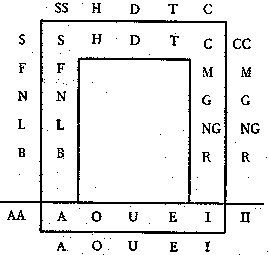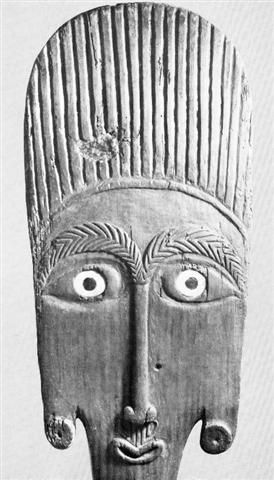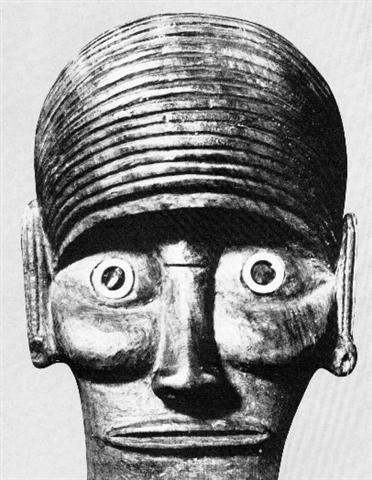4. Polynesia lies mainly below the equator, and instead of a list of birds thriving on land - like the birds corresponding to the Ogham letters (according to The White Goddess) - a list of birds above the water of the sea is more appropriate. The 'waterline' can be imagined as the equator. The form of the cycle of sun light is anyhow the same, and it looks like a door (dolmen):
The vowels are below ground but the consonants mark the advance of light. The letter of the thrush (SS) marks the corner where spring turns into summer. Next corner, when summer turns into autumn, is above marked with the letter CC, but in another version it becomes Q: "Aug. 6 - Sept. 2 - C - (corr, crane); cron, brown. Why is the Crane in the next place? Not hard. This is the month of wisdom, and the wisdom of Manannan Mac Lir, namely the Beth-Luis-Nion, was wrapped in Crane-skin. And brown are the nuts of the Hazel, tree of wisdom. The same - Q - querc, hen; quiar, mouse-coloured. Why is the Hen joined with the Crane? Not hard. When the harvest is carted, and the gleaners have gone, the Hen is turned into the cornfields to fatten on what she can find. And a Mouse-coloured little rival creeps around with her." (The White Goddess). The original 13 consonants above when added to the 5 basic vowels measure out 18 periods for the cycle of the sun (with 20 days in each). But in the bird list of Manuscript E there are 12 'consonants' only, according to my reconstruction:
The male 'fire stick' (teka) is spelled out by verovero and araara, corresponding to the letters N and F. The 'thrush' will in the Easter Island sea bird list be kukuru toua. The 13 consonants are on 'land' and the the hawk (S) is number 5. Then follow H, D, T, and C (the crane) before the descending phase arrives. 5 means the 'fire' of Spring Sun. Then follows the time of Moon (which is described in 2 further phases - the 'Tree' and waning). Manuscript E has 4 + 4 + 4 instead of 5 + 4 + 4. The central 'lintel' carries 4 items in both cases, but instead of 5 for Spring Sun the Easter Island list has 4 (Moon), presumably because of the location of the island (below the tropical belt of Sun). The last pair of the manu tara juveniles (te verovero and ka araara) corresponds to letters N and F, and - remarkably - here we find a sea bird: "Mar. 19 - Apr. 15 - F - faelinn, gull; flann, crimson. Why is the Gull in the next phase? Not hard. In this month Gulls congregate on the ploughed fields. And Crimson is the colour the the glainn, the magical egg which is found in this month, and of alder-dye, and of the Young Sun struggling through the haze." (The White Goddess) Possibly kukuru toua is not a sea bird but a pigeon. If so, it would mirror the gull on land, serve as a mark. A pigeon is no warrior (hakatoua), rather the opposite, a bird of peace. Toua might instead allude to the Tahitian toau, a sign of finality based on counting:
Toau = 2 * 10 = 20 together with the preceding tekau (formed by te verovero and ka araara) are interpretations which support each other.10 periods of Spring Sun are followed by Moon periods (20 nights in each). The 'dart', teka, is followed by taka, the 'circle':
There are only 3 'vowels' (he tuvi, he tuao and he tavi), but presumably we should count also manu tara erua at the top of the bird list in order to reach 5. In a cycle the beginning connects to the end. The central bird in the triplet is tuao, a name looking like an 'inverted' toau. Counting forward 9 steps from tuao we will reach kukuru toua - given that we also count manu tara erua:
Maybe tuao should be read as tu-ao. Ao is the 'day from dawn to dusk'. A symmetry with to-ua can be perceived, with ua (rain) arriving after ao. Ua does not correspond to the tears of those who are lamenting the death of the ao 'bird'. Instead it is the god himself who is 'weeping, and I suggest the following translation:
The 'nose' of ao depicts the trunk of the 'Tree'. In ua we can see that the 'trunk' has been cut across and how the sky roof (the 'lintel') has collapsed:
|
|||||||||||||||||||||||||||||||||||||||||||||||||||||||||||||||||||||||||||||||


